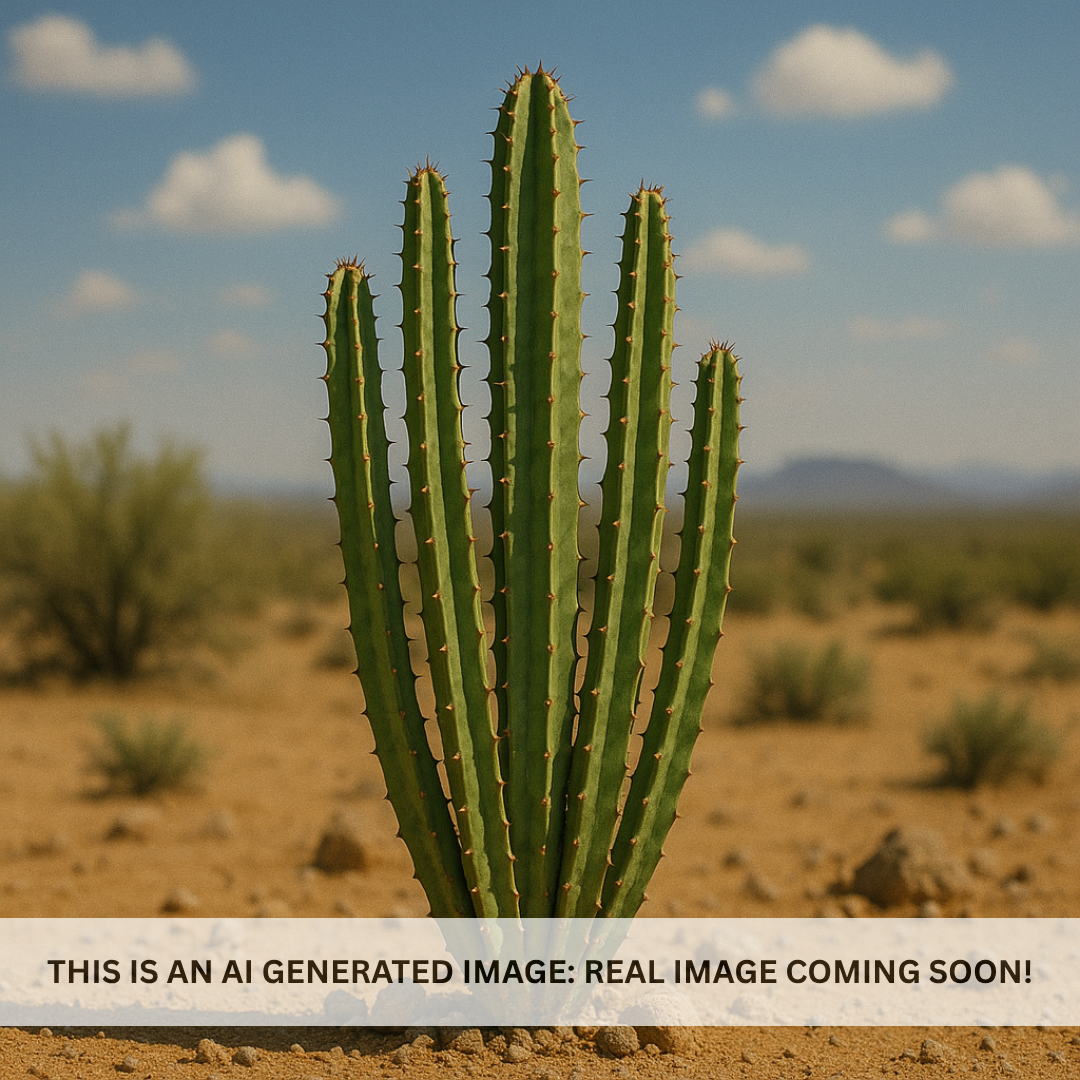My Store
Desert Candle
Desert Candle
Couldn't load pickup availability
Plant Type: perennial, succulent (candelabra-type euphorbia)
Plant Height: 6–12 feet (can reach 15 feet in ideal conditions)
Spread: 3–5 feet
Flower Color: yellow-green (small and subtle)
Sun Exposure: Full sun
Desert Candle (Euphorbia acrurensis): Architectural Height and Sculptural Form for the Modern Desert
The Desert Candle (Euphorbia acrurensis)—also known as the Candelabra Cactus, though it is technically a succulent—is a dramatic, upright species native to eastern and southern Africa. It’s characterized by its tall, multi-branched, columnar form that resembles a living sculpture of green candles rising from the ground. Perfectly suited for Arizona’s desert climate, Euphorbia acrurensis combines architectural structure with remarkable drought tolerance, adding a bold, vertical statement to contemporary and xeriscape landscapes.
Though cactus-like in appearance, this euphorbia’s sap identifies it as a succulent—milky and toxic if touched or ingested—so it should be handled with care.
Key Features of Euphorbia acrurensis
The Desert Candle forms upright, ribbed stems that branch freely from the base, creating a dense candelabra-shaped silhouette. The stems are smooth and rich green, with pronounced ridges lined with small paired spines. Over time, the plant develops a woody base and can form large, sculptural clumps that look like natural art pieces.
In late spring to early summer, small yellow-green flowers (cyathia) appear along the upper ridges, subtle in size but striking against the vivid green stems. The plant’s clean lines and consistent color make it ideal for minimal, modern designs, while its resilience and drought tolerance suit traditional desert gardens equally well.
The milky sap of all euphorbias is toxic and can cause skin irritation—use gloves and eye protection when pruning or replanting.
Growing and Care Tips
Euphorbia acrurensis thrives in full sun and well-draining soil. It performs best in sandy or rocky soils and struggles in heavy clay or areas prone to water pooling.
During establishment, water every 10–14 days in warm months, ensuring the soil dries completely between waterings. Once established, water deeply only every 4–6 weeks in summer and rarely in winter. Overwatering is the primary cause of failure, as this plant is highly sensitive to root rot.
It is hardy to about 25–30°F and should be protected during hard freezes, particularly when young. A frost cloth or light cover is sufficient during short cold spells. Fertilize once a year in spring with a diluted succulent fertilizer to encourage steady growth.
This euphorbia grows quickly in ideal conditions and may reach its mature size within several years, making it an excellent choice for those seeking fast architectural impact.
Landscaping Uses
The Desert Candle’s vertical form and deep green color bring modern elegance and dramatic contrast to xeriscapes, Mediterranean gardens, and contemporary desert landscapes. It is particularly effective as a focal point, architectural accent, or living sculpture in minimalist designs.
It pairs beautifully with low-growing or silver-toned companions such as Agave desmettiana, Blue Glow Agave, Aloe dichotoma, or Golden Barrel Cactus, providing a strong upright counterpoint to rounded forms.
In groupings, Euphorbia acrurensis creates rhythmic vertical repetition that looks striking against gravel or decomposed granite. It also performs exceptionally well in large decorative pots, where it adds sculptural height to patios, courtyards, and poolside settings.
Summary
The Desert Candle (Euphorbia acrurensis) is a showpiece of structure, color, and resilience. Its upright candelabra form, glossy green stems, and strong architectural lines make it an ideal plant for Arizona gardens that blend desert minimalism with modern design. Low-maintenance, fast-growing, and elegant, it brings both strength and serenity to any landscape.
Three Timbers Installation Guide (Feel Free to Follow)
Euphorbia acrurensis Planting Guide
Location: Full sun exposure (at least six hours daily). Protect young plants from strong afternoon sun during their first summer.
Soil: Use fast-draining sandy or rocky soil. A cactus/succulent mix with added pumice or gravel improves aeration and prevents root rot.
Spacing: Space 3–5 feet apart to accommodate mature branching and prevent overcrowding.
Planting Depth: Set the base of the plant level with surrounding soil. Avoid burying stems or applying mulch near the crown.
Support: Young plants may need staking for the first year until the trunk and roots stabilize.
Watering Guide
Watering After Planting: Water deeply once to settle the soil. Allow the soil to dry completely before watering again.
When is the Plant Established? The Desert Candle is considered established after 6–9 months, when new branching and steady vertical growth occur.
Watering Once Established: Water every 4–6 weeks during hot, dry periods in summer and once every 8–10 weeks in winter. Overwatering can cause irreversible root rot.
Drip Irrigation Setup: Use one low-flow emitter (0.5–1 gallon per hour) placed 8 inches from the base. Run sparingly, ensuring full soil drying between watering cycles.
General Watering Tips: Avoid overhead watering to prevent moisture collecting in rib grooves. Use decorative gravel or decomposed granite around the base to suppress weeds and enhance presentation, keeping it several inches from the trunk for airflow.
Share












